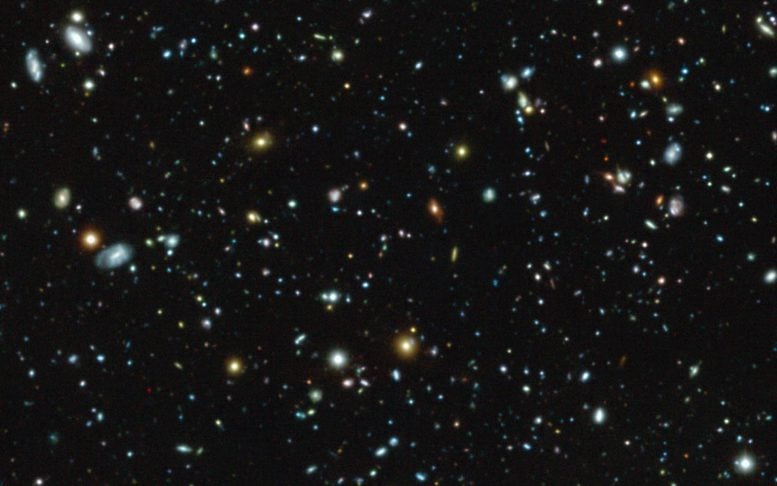
This color image shows the Hubble Ultra Deep Field region, a tiny but much-studied region in the constellation of Fornax, as observed with the MUSE instrument on ESO’s Very Large Telescope. But this picture only gives a very partial view of the riches of the MUSE data, which also provide a spectrum for each pixel in the picture. This data set has allowed astronomers not only to measure distances for far more of these galaxies than before — a total of 1600 — but also to find out much more about each of them. Surprisingly 72 new galaxies were found that had eluded deep imaging with the NASA/ESA Hubble Space Telescope. Credit: ESO/MUSE HUDF collaboration
Astronomers using the MUSE instrument on ESO’s Very Large Telescope in Chile have conducted the deepest spectroscopic survey ever. They focused on the Hubble Ultra Deep Field, measuring distances and properties of 1600 very faint galaxies including 72 galaxies that have never been detected before, even by Hubble itself. This groundbreaking dataset has already resulted in 10 science papers that are being published in a special issue of Astronomy & Astrophysics. This wealth of new information is giving astronomers insight into star formation in the early Universe, and allows them to study the motions and other properties of early galaxies — made possible by MUSE’s unique spectroscopic capabilities.
The MUSE HUDF Survey team, led by Roland Bacon of the Center de recherche astrophysique de Lyon (CNRS/Université Claude Bernard Lyon 1/ENS de Lyon), France, used MUSE (Multi Unit Spectroscopic Explorer) to observe the Hubble Ultra Deep Field, a much-studied patch of the southern constellation of Fornax (The Furnace). This resulted in the deepest spectroscopic observations ever made; precise spectroscopic information was measured for 1600 galaxies, ten times as many galaxies as has been painstakingly obtained in this field over the last decade by ground-based telescopes.
The original HUDF images were pioneering deep-field observations with the NASA/ESA Hubble Space Telescope published in 2004. They probed more deeply than ever before and revealed a menagerie of galaxies dating back to less than a billion years after the Big Bang. The area was subsequently observed many times by Hubble and other telescopes, resulting in the deepest view of the Universe to date. Now, despite the depth of the Hubble observations, MUSE has — among many other results — revealed 72 galaxies never seen before in this very tiny area of the sky.
Roland Bacon takes up the story: “MUSE can do something that Hubble can’t — it splits up the light from every point in the image into its component colors to create a spectrum. This allows us to measure the distance, colors, and other properties of all the galaxies we can see — including some that are invisible to Hubble itself.”
The MUSE data provides a new view of dim, very distant galaxies, seen near the beginning of the Universe about 13 billion years ago. It has detected galaxies 100 times fainter than in previous surveys, adding to an already richly observed field and deepening our understanding of galaxies across the ages.
The survey unearthed 72 candidate galaxies known as Lyman-alpha emitters that shine only in Lyman-alpha light. Current understanding of star formation cannot fully explain these galaxies, which just seem to shine brightly in this one color. Because MUSE disperses the light into its component colors these objects become apparent, but they remain invisible in deep direct images such as those from Hubble.
“MUSE has the unique ability to extract information about some of the earliest galaxies in the Universe — even in a part of the sky that is already very well studied,” explains Jarle Brinchmann, lead author of one of the papers describing results from this survey, from the University of Leiden in the Netherlands and the Institute of Astrophysics and Space Sciences at CAUP in Porto, Portugal. “We learn things about these galaxies that is only possible with spectroscopy, such as chemical content and internal motions — not galaxy by galaxy but all at once for all the galaxies!”
Another major finding of this study was the systematic detection of luminous hydrogen halos around galaxies in the early Universe, giving astronomers a new and promising way to study how material flows in and out of early galaxies.
Many other potential applications of this dataset are explored in the series of papers, and they include studying the role of faint galaxies during cosmic reionisation (starting just 380 000 years after the Big Bang), galaxy merger rates when the Universe was young, galactic winds, star formation as well as mapping the motions of stars in the early Universe.
“Remarkably, these data were all taken without the use of MUSE’s recent Adaptive Optics Facility upgrade. The activation of the AOF after a decade of intensive work by ESO’s astronomers and engineers promises yet more revolutionary data in the future,” concludes Roland Bacon.
This research was presented in a series of 10 papers to appear in the journal Astronomy & Astrophysics.
References:
“The MUSE Hubble Ultra Deep Field Survey: I. Survey description, data reduction, and source detection” by
Roland Bacon, Simon Conseil, David Mary, Jarle Brinchmann, Martin Shepherd, Mohammad Akhlaghi, Peter M. Weilbacher, Laure Piqueras, Lutz Wisotzki, David Lagattuta, Benoit Epinat, Adrien Guerou, Hanae Inami, Sebastiano Cantalupo, Jean Baptiste Courbot, Thierry Contini, Johan Richard, Michael Maseda, Rychard Bouwens, Nicolas Bouché, Wolfram Kollatschny, Joop Schaye, Raffaella Anna Marino, Roser Pello, Christian Herenz, Bruno Guiderdoni and Marcella Carollo, 29 November 2017, Astronomy & Astrophysics.
DOI: 10.1051/0004-6361/201730833
PDF
“The MUSE Hubble Ultra Deep Field Survey: II. Spectroscopic redshifts and comparisons to color selections of high-redshift galaxies” by H. Inami, R. Bacon, J. Brinchmann, J. Richard, T. Contini, S. Conseil, S. Hamer, M. Akhlaghi, N. Bouché, B. Clément, G. Desprez, A. B. Drake, T. Hashimoto, F. Leclercq, M. Maseda, L. Michel-Dansac, M. Paalvast, L. Tresse, E. Ventou, W. Kollatschny, L. A. Boogaard, H. Finley, R. A. Marino, J. Schaye and L. Wisotzki, 29 November 2017, Astronomy & Astrophysics.
DOI: 10.1051/0004-6361/201731195
PDF
“The MUSE Hubble Ultra Deep Field Survey: III. Testing photometric redshifts to 30th magnitude” by J. Brinchmann, H. Inami, R. Bacon, T. Contini, M. Maseda, J. Chevallard, N. Bouché, L. Boogaard, M. Carollo, S. Charlot, W. Kollatschny, R. A. Marino, R. Pello, J. Richard, J. Schaye, A. Verhamme and L. Wisotzki, 29 November 2017, Astronomy & Astrophysics.
DOI: 10.1051/0004-6361/201731351
PDF
“The MUSE Hubble Ultra Deep Field Survey: IV. Global properties of C III] emitters” by Michael V. Maseda, Jarle Brinchmann, Marijn Franx, Roland Bacon, Rychard J. Bouwens, Kasper B. Schmidt, Leindert A. Boogaard, Thierry Contini, Anna Feltre, Hanae Inami, Wolfram Kollatschny, Raffaella A. Marino, Johan Richard, Anne Verhamme and Lutz Wisotzki, 29 November 2017, Astronomy & Astrophysics.
DOI: 10.1051/0004-6361/201730985
PDF
“The MUSE Hubble Ultra Deep Field Survey: V. Spatially resolved stellar kinematics of galaxies at redshift 0.2 ≲ z ≲ 0.8” by Adrien Guérou, Davor Krajnović, Benoit Epinat, Thierry Contini, Eric Emsellem, Nicolas Bouché, Roland Bacon, Leo Michel-Dansac, Johan Richard, Peter M. Weilbacher, Joop Schaye, Raffaella Anna Marino, Mark den Brok and Santiago Erroz-Ferrer, 29 November 2017, Astronomy & Astrophysics.
DOI: 10.1051/0004-6361/201730905
PDF
“The MUSE Hubble Ultra Deep Field Survey: VI. The faint-end of the Lyα luminosity function at 2.91 < z < 6.64 and implications for reionisation” by A. B. Drake, T. Garel, L. Wisotzki, F. Leclercq, T. Hashimoto, J. Richard, R. Bacon, J. Blaizot, J. Caruana, S. Conseil, T. Contini, B. Guiderdoni, E. C. Herenz, H. Inami, J. Lewis, G. Mahler, R. A. Marino, R. Pello, J. Schaye, A. Verhamme, E. Ventou and P. M. Weilbacher, 29 November 2017, Astronomy & Astrophysics.
DOI: 10.1051/0004-6361/201731431
PDF
“The MUSE Hubble Ultra Deep Field Survey: VII. Fe II emission in star-forming galaxies” by Hayley Finley, Nicolas Bouché, Thierry Contini, Mieke Paalvast, Leindert Boogaard, Michael Maseda, Roland Bacon, Jérémy Blaizot, Jarle Brinchmann, Benoît Epinat, Anna Feltre, Raffaella Anna Marino, Sowgat Muzahid, Johan Richard, Joop Schaye, Anne Verhamme, Peter M. Weilbacher and Lutz Wisotzki, 29 November 2017, Astronomy & Astrophysics.
DOI: 10.1051/0004-6361/201731499
PDF
“The MUSE Hubble Ultra Deep Field Survey: VIII. Extended Lyman-α haloes around high-z star-forming galaxies” by Floriane Leclercq, Roland Bacon, Lutz Wisotzki, Peter Mitchell, Thibault Garel, Anne Verhamme, Jérémy Blaizot, Takuya Hashimoto, Edmund Christian Herenz, Simon Conseil, Sebastiano Cantalupo, Hanae Inami, Thierry Contini, Johan Richard, Michael Maseda, Joop Schaye, Raffaella Anna Marino, Mohammad Akhlaghi, Jarle Brinchmann and Marcella Carollo, 29 November 2017, Astronomy & Astrophysics.
DOI: 10.1051/0004-6361/201731480
PDF
“The MUSE Hubble Ultra Deep Field Survey: IX. evolution of galaxy merger fraction up to z ≈ 6” by E. Ventou, T. Contini, N. Bouché, B. Epinat, J. Brinchmann, R. Bacon, H. Inami, D. Lam, A. Drake, T. Garel, L. Michel-Dansac, R. Pello, M. Steinmetz, P. M. Weilbacher, L. Wisotzki and M. Carollo, 29 November 2017, Astronomy & Astrophysics.
DOI: 10.1051/0004-6361/201731586
PDF
“The MUSE Hubble Ultra Deep Field Survey: X. Lyα Equivalent Widths at 2.9 < z < 6.6” by T. Hashimoto, T. Garel, B. Guiderdoni, A. B. Drake, R. Bacon, J. Blaizot, J. Richard, F. Leclercq, H. Inami, A. Verhamme, R. Bouwens, J. Brinchmann, S. Cantalupo, M. Carollo, J. Caruana, E. C. Herenz, J. Kerutt, R. A. Marino, P. Mitchel and J. Schaye, 29 November 2017, Astronomy & Astrophysics.
DOI: 10.1051/0004-6361/201731579
PDF

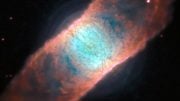
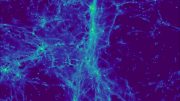
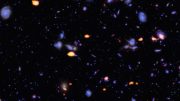
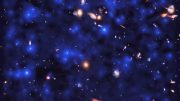

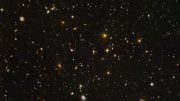
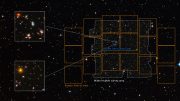
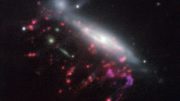
Be the first to comment on "MUSE Conducts the Deepest Spectroscopic Survey Ever"